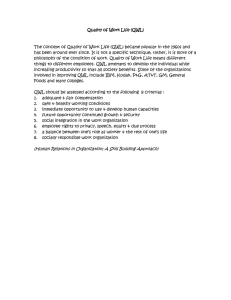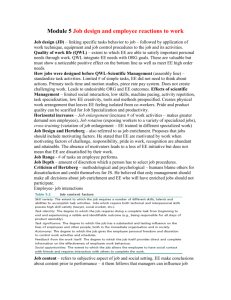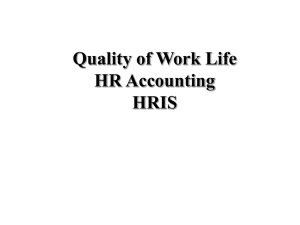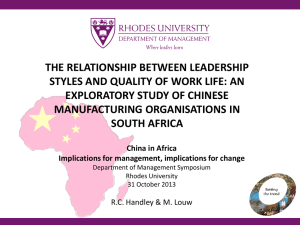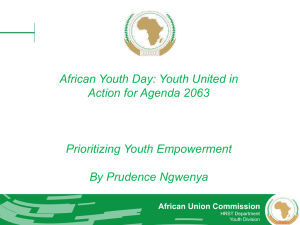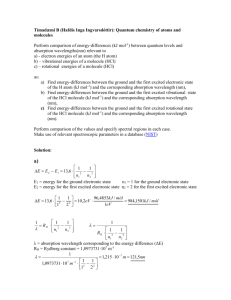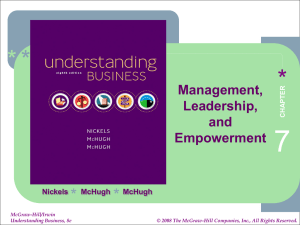Organization Culture and Its Impact on organization
advertisement
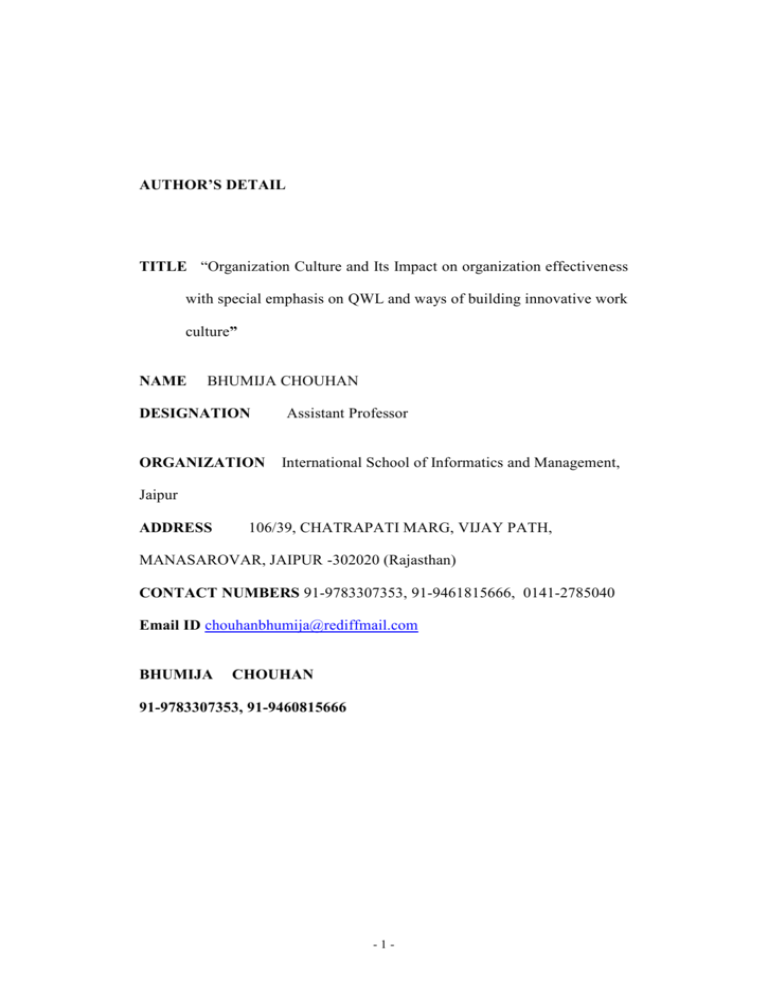
AUTHOR’S DETAIL TITLE “Organization Culture and Its Impact on organization effectiveness with special emphasis on QWL and ways of building innovative work culture” NAME BHUMIJA CHOUHAN DESIGNATION ORGANIZATION Assistant Professor International School of Informatics and Management, Jaipur ADDRESS 106/39, CHATRAPATI MARG, VIJAY PATH, MANASAROVAR, JAIPUR -302020 (Rajasthan) CONTACT NUMBERS 91-9783307353, 91-9461815666, 0141-2785040 Email ID chouhanbhumija@rediffmail.com BHUMIJA CHOUHAN 91-9783307353, 91-9460815666 -1- “Organisation Culture and Its Impact on organization effectiveness with special emphasis on, QWL and ways of building innovative work culture” BHUMIJA CHOUHAN Assistant .Professor, IIIM, Jaipur ABSTRACT Organization culture is the set of important understandings, such as norms, values, attitudes and beliefs shared by organizational members. Culture therefore, is how an organization learned to deal with its environment. It is a complex mixture of assumptions, behaviors, stories, myths, metaphor and other ideas that fit together to define what it mean to work in a particular organization. When we say that there is a culture of safety DuPoint, a culture of service at Dell and a culture of innovation at 3M. We are saying that people at these organizations has learned a particular way to deal with lot of complex issues. Organization culture provides the members with a sense of organizational identity and generates a commitment to beliefs and values that are larger then themselves. This paper throws light on organisation culture and its impact on employees affectivity and efficiency. This paper analyzes the importance of healthy work culture, improvement of employees and organizational efficiency .The -2- paper proposes various ways of building an innovative work culture and importance of QWL (Quality of work life). Keywords: Organization culture, QWL (Quality of work life), Confrontation -3- INTRODUCTION The word work culture is made up of two words "Work + Culture". Work is defined as the tasks that need to be done by use of physical strength or mental power in order to do. Culture is defined as a cumulative crystallized and quasistable shared life style of people as reflected in the preference of some states of life over others (values) in the response predisposition towards several significant issues and phenomena (attitudes) in the certain affairs (rituals) and in the ways of promoting desired, preventing indescribable behavior (sanctions) According to Hofstede Culture is to a human collectivity what personality is to an individual. Culture could be defined as the interactive aggregate of common characteristics that influence a human group response to its environment. Culture determines the identity of an individual. More over, the two interact; "Culture and personality" is a classic name for psychological anthropology. Cultural traits some times can be measured by personality tests. Culture is the complex mixture of assumption, behaviors, myths, metaphors and other ideas that fit together to define what it mean to be a member a particular society. Organization may develop their own unique culture that differentiates them from other organization within the industry or society. CULTURE IS LEARNT Individual beliefs, attitudes and values are gained from the individual's environment. The culture of the organization is therefore gained from the -4- environment common to its members. Both the internal and the external environment of the organization influence culture. Organization culture is the set of important understandings, such as norms, values, attitudes and beliefs shared by organizational members. Culture therefore, is how an organization learned to deal with its environment. It is a complex mixture of assumptions, behaviors, stories, myths, metaphor and other ideas that fit together to define what it mean to work in a particular organization. When we say that there is a culture of safety DuPoint, a culture of service at Dell and a culture of innovation at 3M. We are saying that people at these organizations has learned a particular way to deal with lot of complex issues. Organization culture provides the members with a sense of organizational identity and generates a commitment to beliefs and values that are larger then themselves. Though ideas that become the part of culture can come from any where with in the organization, an organizations culture generally begins with a founder or early reader who articulates and implement ideas and values as a vision, philosophy, business strategy. In Schein's theory, culture exists on three levels: -5- Figure 1: Schein's three levels of organization culture The most important aspect of organization or work culture is the values it practices. There are 8 values which can be examined to develop the profile of an organization or work culture. Openness Confrontation Trust Authenticity Pro activity Autonomy Collaboration Experimenting The more important factor that acts as a prerequisite for the high performance workplace is a "High Performance Culture". Some important aspects of organization culture in high performance are: 1. Leadership that empowers others. 2. Borderless sharing of power. 3. A relentless focus on strategy and results. 4. Values of accountability, transparency and belongingness. 5. Personal responsibility. -6- 6. High employee and employer involvement and commitment. 7. High level of trust. 8. Open sharing of relevant information. 9. Partnering. The key aspect in a high performing organization culture, employees have a sense of personal responsibility for understanding and staying current with external trends in the environment. Being personally responsible makes individuals adhere to their commitment. They are aware of the relevant strengths and weakness within their organization and they have ability to assess whether external events will potentially translate into opportunities threads or constraints for their organizations. Trust is another major component of high performance work culture which occurs through openness, acceptance of one another, belonging ness, reliability on one another and informal work setting. High performing organization culture allows immense coordination and involvement amongst all levels of employees and management and unions stock. Such a culture would demand innovation and creativity from the employee's behalf. For building innovative work cultures following points are considered. Promote Individual Growth Create a Sense Belonging Build Confidence Optimize the Work Environment Best Practices for building innovative work Culture: Invest in employees growth Make training mandatory -7- Acknowledge innovative contribution Instill ownership and accountability Create a sense of belonging Build Confidence through encouragement Leverage the strengths of individuals Support amnesty Improve the physical work environment Capture innovative ideas through multiple mediums Promote a culture of continuous improvement Leaders in a variety of industries have identified multiple mediums where innovative thinking can be captured. Pfizer has successfully implemented a suggestion box program that offers cash bonuses for employee ideas that are put into action. GE frequently holds cross-functional rapid design sessions known as "Work-O Outs" to generate innovative ideas and solve business problems. IDEO encourages collaboration through the visual presentation of project related knowledge (brainstorming, post-it notes, pictures, etc.) on movable office walls that surround the area where project work is conducted. To have a good performing work culture in organization following things we kept in practice. 1. Stringent staffing procedure, selecting only who hold values of commitment, accountability and personal responsibility in them. -8- 2. Instill and maintain shared pattern of norms, values informal rules within organization which in turn should be communicated vigorously and effectively to every employee in the firm. 3. Job design and appropriate competency mapping. 4. Instill high performance teem based system which in turn carry a deeper sense of purpose with more ambitious performance goals. 5. Employee participation and empowerment in major and minor key decision areas. 6. Competency mapping. 7. Instill high performance Job design and appropriate teem based system which in turn carry a deeper sense of purpose with more ambitious performance goals. 8. Employee participation and empowerment in major and minor key decision areas. 9. Self leading practices complemented with job enrichment or enlargement increased accountability should be put in operation. 10. Continuous leading environment. 11. Performance contingent incentives, compensation. 12. Faster and fair career development. STUDY The relevance and need of the present study arose from an epoch making and enriched conceptual premise of the study entitled as -"Cultural Dimensions of Work Related Values-In the East." Developed by the two investigators -9- of the project, in study has formed a part of the proceedings of 'Australian Psychological Society', Published in 1994.The priorities or determinates of work culture in the East, i.e. in the developing have been for affiliation and the cultural value of collectivism. Subsequently, Misumi in 1995, opened up avenues for gathering empirical data as well as for testing the predictions regarding determinates the of work culture. New methodological vitas have been to assess the impact of the personalized relationship, growth, and development of work culture among management teachers. The study emerged on the basis of following equation for investigation was derived as follows: WC = a2 WC = work culture Al = Accountability A2 = Accreditability Or WC = e2 Here, E1 = Endogenous E2 = Exogenous Here, The relevance of this equation lies in explaining the diminished and poor job performance, resulting in low accredits ability. One would consider quality of work life, as an important moderator variable, which is by and large positively correlated to work-culture. Saharan (1989) in his well-known book on Organizational Behavior - 10 - published at New Delhi by JMG, has operationally defined it as the sum total of healthy experiences that individuals have in various facts of their life. Most commonly measured indices of employees in any organization include a trilogy of three indices. 1. The extent of job-involvement 2. The same of competence 3. Job-satisfaction. Considering holistically more so in recent years measures of mental health i.e. positive sense of well-being is being regarded as the ultimate indices of the quality of work life experienced by the academic community. An individual's general attitude towards his job itself can cause some personal and societal consequences, including feelings of powerlessness, and professional neglect may lead to poor mental health, due to a persistent and pressing source of dissatisfaction. There has been ample evidence, shown among industrial workers by Kornhauser as early as in 1965, who had observed a consistent relationship between dissection and measures of mental health, which include feelings of inadequacy, anxiety, tension, hostility, low self-esteem etc. Some of measures of lack of well-being or mental health include, insecurity, irritation, lack of or low-self-esteem which are regarded as consequences "STRESS STATE", OR:" EXPERECENCED AND FELT STRESS". Mental health or wellness indicator of job dissatisfaction as well. Therefore, if an employee institute remains - 11 - constantly and continuously dissatisfied for whatever reasons m he or she is likely to experience strain. So it often been predicted that those who are more satisfied with their jobs might experience less strain, or job stress than those who are satisfied similar prediction can be about work commitment, which is the core component of work culture, i.e. persons manifesting or possessing more work-commitment would eventually live and work in a better work culture. So, if in all probability, there are likely to be positive indicators of workculture viz. job commitment, and negative indication viz. absenteeism. Quality of work-life (QWL) refers to overall climate of work, and its impact on people. It, essentially stems from an interaction of personal and organizational factor. The organization roots of work culture are located in "working condition", various job characteristics and job demand and more essentially the organization mission (zeal - sprit) and administrative openness etc. The personal indicators of quality of working life (QWL) are found in values, aspiration, attitude towards work and life and dimension of values and aspirations. 1. Growth and innovation 2. Helping behavior 3. Personalizing relationship 4. Individual dignity 5. Shared out look - 12 - According to Biswas, U. Nand Mathew, R (2001) changing concepts regarding work-environment and work-culture have come into light with the advent of total quality management (TQM). In the notion of total quality management lot of stress has been put on the process of empowering. An operational framework has been developed by Biswas for measuring people's empowerment at work in academic settings. The findings of this study suggested that the perceived empowerment does not effect perception of work-climate, learning environment, decision involvement and goal clarity emerged as salient empowerment par aments, that effects and leads to a favorable work-culture. Few other indicators have also found that were related to task assignment and communication as well as colleague management. Initially Conger J.A & Kanungo, R.N (1988) has formulated five stages of empowerment process which has been diagrammatically shown below. - 13 - The eight dimensions of empowerment scale developed by Biswas based on Decision Involvement Learning Environment Fairness System Resistance Organizational Pride Support Climate Goal Clarity Teamwork The main finding of this test suggested that organizational effectiveness is dependent upon perception of organizational climate. However, the main findings of Biswas & Mathew's study highlights, the significant and unique contribution of decision involvement and support climate to the predictability of work-culture . It was found to be quite crucial. The Human Resource management group at INDIAN INSTITUTE OF MANAGEMENT Lucknow explodes the role and relevance of the aspects - 14 - such as self-esteem, internal work-motivation, and increased awareness of self-monitoring as being influenced by moderator variable known as workculture (study by Sunita Rai & Arvind Sinha (2001). Finally, the authors go on to say that the study provides an indication that the concepts of selfmonitoring have same relevance across cultures (eg.: Indian setting as in present case). IMPORTANCE OF THE RESEARCH WORK Work Culture plays an important role to identify and examine the internal environment of any organization .Work Culture tells information of the employees working. Work culture is today's hot issue to be discussed by various famous companies to increase the productivity of employees because work culture is the major player which puts impact on the working style and art of employees. Work Culture in some of the organization plays the role of mentor or creator but in some organization it plays the role of destroyer. Work culture has significant influence on the attitudes and behaviors complied with values on the organization members. Once a culture is in place are forces within the organization that act to maintain it by giving employees a set of similar experiences. The three forces that play the most important part of sustaining culture are the organization selection process, the action of top management, and the organization socialization method. Work culture performs a number of functions in an organization. - 15 - 1. It has a boundary defining role i.e. it creates of distinctions between one organization and others. 2. It conveys a sense of identity for organization member. 3. It facilitates the generation of commitment to something larger then ones individual self interest. 4. It enhances the stability of the social system. 5. It lays the stability impact on attitude and behavior. CONCLUSION This study can help organization to pay more attention and be more focused to maintain a good organizational culture .As organizational culture is the mirror of organizations functioning which can make or break the image and goodwill. The QWL is also useful for controlling attrition rate in organization. In present scenario every organization is getting involved to provide best of the best work culture to enhance the work life as well as the quality life of employees in organization. REFERENCES 1. Biswas U & Nanda Mathew R(2001) Imp act of perceived empowerment on Managerial Effectiveness 2. Borg 1(1991) on the relationship between importance and satisfaction ratings on job aspects.Applied Psychological International Review vol. 40 pg 93 -104 3. Dafftuar C.N.L Nair, culture”vol 57 - 16 - Pri ya(2001)”organizationa l 4. E. H Scein(1995) Organisation culture & Leardship Jossey Bass, San Francisco 5. Iztak, Harpez(1988) variables effecting non financial employment commitment, applied psychological International review vol 31 pg 235 -248 6. Khaleque.A and Nasreen w adud Perceived importance of job satisfaction and overall job satisfaction of industrial supervision. 7. Kothari C.R (2004)”Research methodology Methods and Techniques.” 8. Malhotra,Sinha etal(2001)QWL and absenteeism in organization in Indian psychological revi ew vol. 56 pg 31-34 9. Mishra & Mishra b & Mahapatra M(2001)” Job -Lay-Off – The challenge of new millennium” 10. Nanda, U B & Mathew R(2001)”The Human resource imperative”: IPR 11. Poulton R.G & Ng.S.H(1998) relationshiop between protestant work ethic and work effect in a field seting applied psychological international review vol 37. 12. S.Rai (2001) Human Resourse Management “Personal effectiveness” IIM Lucknow vol. 57 pg 132 - 17 - 13. Sekaran (1989)”organization behaviour” -New Delhi,JMG publication 14. Singh R P & Chabbar T N (2004) Danpat Rai & CO.Pvt Ltd “Organization theory and behaviour”. 15. Sinha S.N, A.Sinha and B.L.Kotia(2001) -“Human Resourse Planning in Organisation “vol. 56 pg 38 -40. - 18 -
